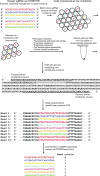Integrated design, execution, and analysis of arrayed and pooled CRISPR genome-editing experiments
- PMID: 29651054
- PMCID: PMC6182299
- DOI: 10.1038/nprot.2018.005
Integrated design, execution, and analysis of arrayed and pooled CRISPR genome-editing experiments
Abstract
CRISPR (clustered regularly interspaced short palindromic repeats) genome-editing experiments offer enormous potential for the evaluation of genomic loci using arrayed single guide RNAs (sgRNAs) or pooled sgRNA libraries. Numerous computational tools are available to help design sgRNAs with optimal on-target efficiency and minimal off-target potential. In addition, computational tools have been developed to analyze deep-sequencing data resulting from genome-editing experiments. However, these tools are typically developed in isolation and oftentimes are not readily translatable into laboratory-based experiments. Here, we present a protocol that describes in detail both the computational and benchtop implementation of an arrayed and/or pooled CRISPR genome-editing experiment. This protocol provides instructions for sgRNA design with CRISPOR (computational tool for the design, evaluation, and cloning of sgRNA sequences), experimental implementation, and analysis of the resulting high-throughput sequencing data with CRISPResso (computational tool for analysis of genome-editing outcomes from deep-sequencing data). This protocol allows for design and execution of arrayed and pooled CRISPR experiments in 4-5 weeks by non-experts, as well as computational data analysis that can be performed in 1-2 d by both computational and noncomputational biologists alike using web-based and/or command-line versions.
Conflict of interest statement
The authors declare no competing interests.
Figures




References
-
- Barrangou R, et al. CRISPR provides acquired resistance against viruses in prokaryotes. Science. 2007;315:1709–1712. - PubMed
Publication types
MeSH terms
Substances
Grants and funding
LinkOut - more resources
Full Text Sources
Other Literature Sources
Research Materials

